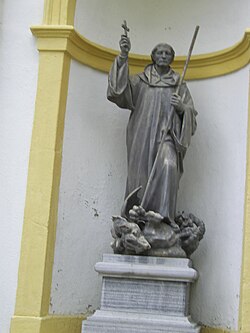Magnus of Füssen
Saint Magnus of Füssen | |
|---|---|
 Statue of St Mang of Füssen outside the Basilica of St Mang in Füssen, Bavaria. | |
| Died | 7th or 8th century |
| Feast | 6 September |
Magnus of Füssen, otherwise Magnoald or Mang, was a missionary saint in southern Germany, also known as the Apostle of the Allgäu. He is believed to have been a contemporary either of Gall (died 627) or of Boniface (died 754) and is venerated as the founder of St. Mang's Abbey, Füssen.
Legend
There is almost no reliable information about him. The only source is an old "Vita S. Magni", which however contains so many obvious
About this time a priest of the
He was buried in the church he had constructed. In 851 he was reburied in the newly erected church. One of his bones was sent to
Vita

The "Life" was said to have been written by Theodore, the companion of Magnus, under whose head it was placed in the grave. When in 851 Bishop Lanto transferred the relics to the newly erected church of Füssen, this "Life" is said to have been found in a scarcely legible condition, and to have been emended and re-written by Ermenrich, a monk of
The chief inconsistencies in the "Life" are the following: Magnus is made a disciple of Gall (died 627) and at the same time he is treated as a contemporary of Wichbert, the first historically established
Life
In reality, Magnus was probably working on behalf of Bishop Wikterp together with Tozzo and Theodor from about 746 in
Magnus is the patron saint of the Allgäu, von Füssen, and Kempten; and is invoked for the protection of cattle; and against eye diseases, snakebite, worms, rats, mice and field insects. His feast is celebrated on 6 September.[4]
The veneration of Saint Magnus was carried to the New World by the German Catholic peasant pioneers whom Francis Xavier Pierz had persuaded to settle in Central Minnesota following the Treaty of Traverse des Sioux in 1851. Magnus, whose intercession was credited with the defeat of the 1856-1857 Rocky Mountain locust plague, continued to be widely venerated in and around Stearns County, Minnesota, as a patron of good harvests and as the protector against lightning, hail, and plagues of vermin. Furthermore, his Feast Day on September 6 continued to be celebrated until well into the 1870s, both in and around Jacobs Prairie, Minnesota, as, "Grasshopper Day." (See also Assumption Chapel)[5]
The cult of
References
- ^ a b c Ott, Michael. "St. Magnus." The Catholic Encyclopedia Vol. 9. New York: Robert Appleton Company, 1910. 8 Nov. 2017
- ^ Acta SS. O.S B., II, 505 sq.
- ^ first put forward by Staichele and Baumann
- ^ a b Schäfer, Joachim. "Magnus von Füssen", Ökumenisches Heiligenlexikon, September 12, 2006
- S2CID 159890053.
- ^ Pomi, Damiano (July 16, 2004). "San Magno". Santi e Beati. Retrieved December 28, 2008.
![]() This article incorporates text from a publication now in the public domain: Herbermann, Charles, ed. (1913). "St. Magnus". Catholic Encyclopedia. New York: Robert Appleton Company.
This article incorporates text from a publication now in the public domain: Herbermann, Charles, ed. (1913). "St. Magnus". Catholic Encyclopedia. New York: Robert Appleton Company.
